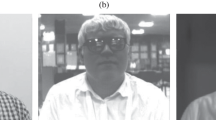Abstract
Opto-electronic performance of the InGaAs/i-InGaAs/InP short wavelength infrared focal plane array suitable for high resolution imaging under low flux conditions and ranging is presented. More than 85% quantum efficiency is achieved in the optimized detector structure. Isotropic nature of the wet etching process poses a challenge in maintaining the required control in the small pitch high density detector array. Etching process is developed to achieve low dark current density of 1 nA/cm2 in the detector array with 25 µm pitch at 298 K. Noise equivalent photon performance less than one is achievable showing single photon detection capability. The reported photodiode with low photon flux is suitable for active cum passive imaging, optical information processing and quantum computing applications.









Similar content being viewed by others
References
D. Fan, K. Lee, S.R. Forrest, Flexible thin-film InGaAs photodiode focal plane array. ACS Photonics 3(4), 670–676 (2016)
H. Figgemeier, M. Benecke, K. Hofmann, R. Oelmaier, A. Sieck, J. Wendler, J. Ziegler, SWIR detectors for night vision at AIM. Proc. SPIE 9070, 907008 (2014)
J. Zhang, M.A. Itzler, H. Zbinden, J.-W. Pan, Advances in InGaAs/InP single-photon detector systems for quantum communication. Light Sci. Appl. 4, e286 (2015)
R.H. Hadfield, Single photon detectors for optical quantum information applications. Nat. Photon 3, 696 (2009)
F. Rutz, P. Kleinow, R. Aidam, H. Heussen, W. Bronner, A. Sieck, M. Walther, SWIR photodetector development at Fraunhofer IAF. Proc. SPIE 9481, 948107 (2015)
A. Rogalski, J. Antoszewski, L. Faraone, Third-generation infrared photodetector arrays. J. Appl. Phys 105, 091101 (2009)
H. Inada, K. Machinaga, S. Balasekaran, K. Miura, T. Kawahara, M. Migita, K. Akita, Y. Iguchi, Recent development of SWIR focal plane array with InGaAs/GaAsSb type-II quantum wells. Proc. SPIE 9819, 98190C (2016)
M. Verdun, G. Beaudoin, B. Portier, N. Bardou, C. Dupuis, I. Sagnes, R. Haidar, F. Pardo, J.-L. Pelouard, Dark current investigation in thin P-i-N InGaAs photodiodes for nano-resonators. J. Appl. Phys 120, 084501 (2016)
T. Asar, S. Ozcelik, E. Ozbay, Structural and electrical characterizations of Inx Ga1–x As/InP structures for infrared photodetector applications. J. Appl. Phys. 115, 104502 (2014)
R. Dewames, R. Littleton, K. Witte, A. Wichman, E. Bellotti, J. Pellegrino, Electro-optical characteristics of P+n In0.53Ga0.47As hetero-junction photodiodes in large format dense focal plane arrays. J. Electron Mater. 44(8), 2813–2822 (2015)
J. Ma, Z. Zhang, G. Miao, Y. Zhao, Design and performance analysis of extended wavelength InGaAs near-infrared photodetectors. Jap. J. Appl. Phys. 54, 10431 (2015)
M. MacDougal, J. Geske, C. Wang, S. Liao, J. Getty, A. Holmes, Low dark current InGaAs detector arrays for night vision and astronomy. Proc. SPIE 7298, 72983F (2009)
Q.Y. Zeng, W.J. Wang, J. Wen, L. Huang, X.H. Liu, N. Li, W. Lu, Effect of surface charge on the dark current of InGaAs/InP avalanche photodiodes. J. Appl. Phys. 115, 164512 (2014)
A. Wieczorek, V. Djara, F.H. Peters, J. O’Callaghan, K. Thomas, B. Corbett, Inductively coupled plasma deep etching of InP/InGaAsP in Cl2/CH4/H2 based chemistries with the electrode at 20 °C. J. Vac. Sci. Technol. B 30(5), 051208 (2012)
S.R. Forrest, Performance of InxGa1–xAsyP1–y photodiodes with dark current limited by diffusion, generation recombination, and tunnelling. IEEE J. Quantum Electron 17(2), 217–226 (1981)
A. Averbuch, G. Liron, B.Z. Bobrovsky, Scene based nonuniformity correction in thermal images using Kalman filter. Image Vision Comput. 25(6), 833–851 (2007)
M.J. Cohen, M.H. Ettenberg, M.J. Lange, G.H. Olsen, An Indium Gallium Arsenide Visible/SWIR Focal Plane Array for Low Light Level Imaging Report (Sensors Unlimited Inc., Princeton, 1999)
Acknowledgements
Authors thank Director, SSPL Delhi for permission to publish this paper.
Author information
Authors and Affiliations
Corresponding author
Appendix
Appendix
The effective carrier lifetime for electron (τ e) and hole (τ p) is given as
where τ SRH = SRH life time. The n 0 and p 0 are carrier concentration for electron and hole at thermal equilibrium, respectively. G ee, G hh and G RAD are respective generation rate. The γ and δ are given as
where N T is the trap density, α is the absorption coefficient and f T is the Fermi level in the trap states.
Total SRH lifetime is given as
Empirically fitted formulation for lifetime in InGaAs is given as (N = doping density):
where τ SRH = 47.4 μs, B = 1.43 × 10−10 cm−3 s−1, C = 8.1 × 10−29 cm−6 s−1.
Surface recombination velocity (s) is given as
where Ψ s and Ψ 0 are the surface potential and bulk potential, respectively. K n and K p are the probability of capturing electron and hole, respectively; K n = 2–6 × 1015 cm2, K p = 1–3 × 1015 cm2 and \({\psi _{\text{s}}}=\frac{{qNW}}{{2{\varepsilon _{\text{s}}}}}\)
where A j and W are area and width of the junction. The n i and τ eff are intrinsic carrier concentration and effective life time, respectively. \(f(b)=\frac{{\left| {{E_{\text{t}}} - {E_{\text{i}}}} \right|/kT}}{{\exp \left( {\left| {{E_{\text{t}}} - {E_{\text{i}}}} \right|/kT} \right)}}\); In general f(b) ~ 1 is taken.
G–R surface contribution in the mesa geometry is given as
where collection area, A o,p = (A j 1/2 + 2L e)2; L e is diffusion length of electron.
The photo current is given as
Quantum efficiency (η) is given as
where R is the back side reflection of infrared radiation. The W f, W j and W b are the thickness of the front region, junction region and back side region, respectively. The thickness of back side region changes with the variation of the absorber layer.
The number of electrons collected from the detector as a function of irradiance and IR background is given as
where t i is the integration time, M is the avalanche gain, and η i is the injection efficiency for a DI/BDI circuit. The I d and I ph are the dark current and photo current, respectively.
Then, NEPh is given as
where F(M) = excess noise factor and τ gate = integration period.
Rights and permissions
About this article
Cite this article
Singh, A., Pal, R. Performance of InGaAs short wave infrared avalanche photodetector for low flux imaging. Appl. Phys. A 123, 701 (2017). https://doi.org/10.1007/s00339-017-1321-7
Received:
Accepted:
Published:
DOI: https://doi.org/10.1007/s00339-017-1321-7



